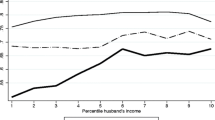Abstract
This paper presents a discrete choice static neo-classical labor supply model for married or cohabiting couples in the Netherlands. The model simultaneously explains the participation decision and the desired number of hours worked. Due to its discrete nature, institutional details of the tax system can be fully incorporated. The model is estimated using Dutch cross-section data. The results are used to simulate the first order labor supply effects of several proposed reforms of the Dutch income tax system. In particular, it is shown that some of the proposed reforms would have a negative effect on the number of married females who prefer a small part-time job. This pitfall is avoided in the proposal that has gone to Parliament.
Similar content being viewed by others
REFERENCES
Apps, P.F. and R. Rees (1996), ‘Labor Supply, Household Production and Intra-Family Welfare Distribution,’ Journal of Public Economics, 90, pp. 199–219.
Blomquist, N. (1983), ‘The Effect of Income Taxation on the Labor Supply of Married Men in Sweden,’ Journal of Public Economics, 22, pp. 169–197.
Blundell, R. (1994), ‘Evaluating Structural Microeconometric Models of Labor Supply,’ in: C. Sims (ed.), Advances in Econometrics Sixth World Congress, II, Cambridge University Press, Cambridge, pp. 3–48.
Blundell, R. and I. Walker (1986), ‘A Life Cycle Consistent Empirical Model of Labor Supply using Cross-Section Data,’ Review of Economic Studies, 53, pp. 539–558.
Blundell, R. and T. MaCurdy (1999), ‘Labor Supply: A Review of Alternative Approaches,’ in: O. Ashenfelter and D. Card (eds.), Handbook of Labor Economics, 3A, North Holland, Amsterdam, pp. 1559–1696.
Callan, T. and A. van Soest (1996), Family Labor Supply and Txes in Ireland, mimeo, Tilburg University.
Card, D. (1994), ‘Intertemporal Labor Supply: An Assessment,’ in: C. Sims (ed.), Advances in Econometrics Sixth World Congress, II, Cambridge University Press, Cambridge, pp. 49–80.
Dickens, W. and S. Lundberg (1993), ‘Hours Restrictions and Labor Supply,’ International Economic Review, 34, pp. 169–192.
Euwals, R. and A. van Soest (1999), ‘Desired and Actual Labour Supply of Unmarried Men and Women in the Netherlands,’ Labour Economics, 6, pp. 95–118.
Gelauff, G. and J. Graafland (1994), Modelling Welfare State Reform, North Holland, Amsterdam.
Grift, Y. (1998), Female Labor Supply: The Influence of Taxes and Social Premiums, PhD thesis, University of Utrecht.
Hajivassiliou, H. and P. Ruud (1994), ‘Classical Estimation Methods for LDV Models using Simulation,’ in: R.F. Engle and D.L. McFadden (eds), Handbook of Econometrics, IV, North Holland, Amsterdam, pp. 2384–2443.
Hausman, J. (1985), ‘The Econometrics of Nonlinear Budget Sets,’ Econometrica, 53, pp. 1255–1283.
Hausman, J. and P. Ruud (1984), ‘Family Labor Supply with Taxes,’ American Economic Review, 74, pp. 242–248.
Heckman, J. (1979), ‘Sample Selection Bias as a Specification Error,’ Econometrica, 47, pp. 153–161.
Heckman, J. (1993), ‘What Has Been Learned about Labor Supply in the Past Twenty Years?,’ American Economic Review, 83, pp. 116–121.
Ilmakunnas, S. and S. Pudney (1990), ‘A Model of Female Labor Supply in the Presence of Hours Restrictions,’ Journal of Public Economics, 41, pp. 183–210.
Killingsworth, M. and J. Heckman (1986), ‘Female Labor Supply: A Survey,’ in: O. Ashenfelter and R. Layard (eds.), Handbook of Labor Economics, 1, North Holland, Amsterdam.
Kooreman, P. and A. Kapteyn (1990), ‘On the Empirical Implementation of Some Game-theoretic Models of Household Labor Supply,’ Journal of Human Resources, 25, pp. 584–598.
MaCurdy, T., D. Green, and H. Paarsch (1990), ‘Assessing Empirical Approaches for Analyzing Taxes and Labor Supply,’ Journal of Human Resources, 25, pp. 415–490.
Ministry of Finance (1997), Belastingen in de 21-ste eeuw: een verkenning, SDU Publishers, The Hague.
Ministry of Finance (1999), Wet inkomstenbelasting 2001, SDU Publishers, The Hague.
Moffitt, R. (1984), ‘Estimation of a Joint Wage-Hours Labor Supply Model,’ Journal of Labor Economics, 2, pp. 550–556.
Moffitt, R. (1986), ‘The Econometrics of Piecewise Linear Budget Constraints: A Survey and Exposition of the Maximum Likelihood Method,’ Journal of Business and Economic Statistics, 4, pp. 317–327.
Moffitt, R. (1990a), ‘The Econometrics of Kinked Budget Constraints,’ Journal of Economic Perspectives, 4, pp. 119–139.
Moffitt, R. (1990b), ‘Special Issue on Taxation and Labor Supply in Industrial Countries,’ Journal of Human Resources, 25, pp. 313–558.
Soest, A. van, I. Woittiez and A. Kapteyn (1990), ‘Labor Supply, Income Taxes and Hours Restrictions in the Netherlands,’ Journal of Human Resources, 25, pp. 517–558.
Soest, A. van (1995), ‘Discrete Choice Models of Family Labor Supply,’ Journal of Human Resources, 30, pp. 63–88.
Theeuwes, J. (1988), ‘Arbeid en belastingen,’ in: Belastingheffýng en Belastinghervorming, Koninklijke Vereniging voor Staathuishoudkunde, Stenfert Kroese, Leiden, pp. 111–143.
Tummers, M. and I. Woittiez (1991), ‘A Simultaneous Wage and Labor Supply Model with Hours Restrictions,’ Journal of Human Resources, 26, pp. 393–423.
Vlasblom, J.D. (1998), Differences in Labor Supply and Income of Women in the Netherlands and the Federal Republic of Germany, PhD thesis, University of Utrecht.
Author information
Authors and Affiliations
Rights and permissions
About this article
Cite this article
van Soest, A., Das, M. Family Labor Supply and Proposed Tax Reforms in the Netherlands. De Economist 149, 191–218 (2001). https://doi.org/10.1023/A:1017531304601
Issue Date:
DOI: https://doi.org/10.1023/A:1017531304601




